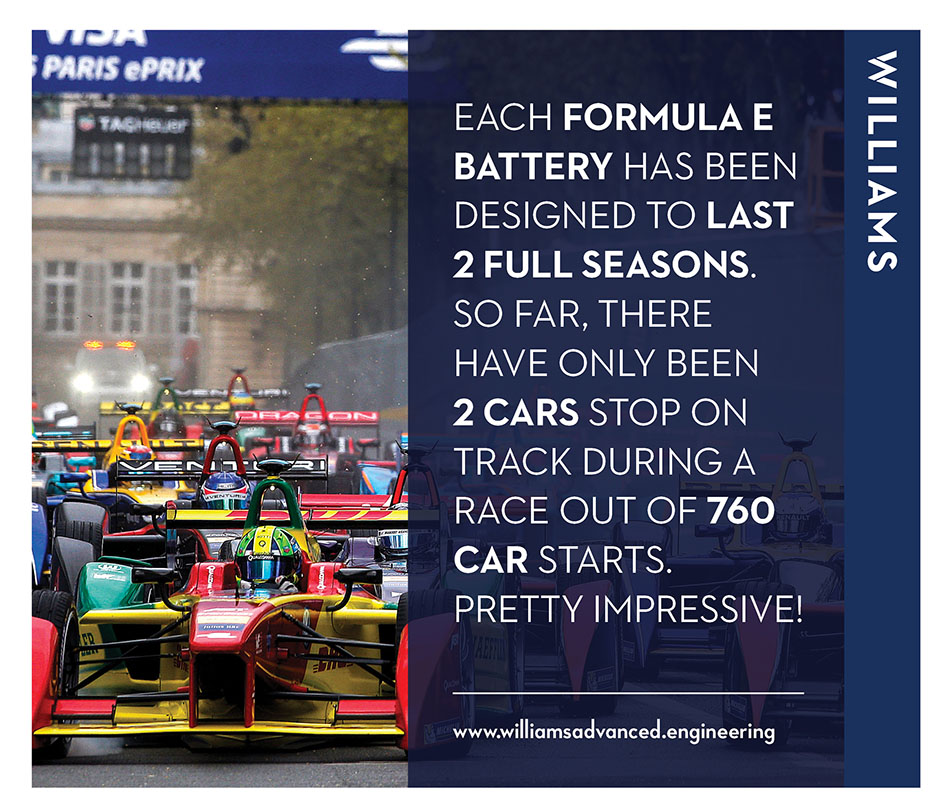The Formula E Battery: A Q&A with Paul McNamara, Williams Advanced Engineering
 |
As we approach the 2016/17 FIA Formula E season finale, culminating in a double-header in London’s Battersea Park, we caught up with Paul McNamara, Technical Director at Williams Advanced Engineering, to see how the battery has developed in season two and how this technology might impact the future of the automotive industry.
Q: After two seasons of Formula E, what have been the major breakthroughs of the project?
A: For us, Formula E acts as a proving ground for high power batteries working in harsh environments. We have been able to fully test and validate our cooling systems, charge retention and module design, and apply this technology to other projects outside of motorsport.
One of the key issues that we have wanted to address is the vibration and track loading demands of the street circuits used in Formula E. With new Formula E tracks being built specifically for the series on public roads, we had to make a series of assumptions in our original design without any data. Another difficulty was thermal management, given that batteries heat up rapidly when used in a harsh environment like a race track. Now, with real-life experience of the race locations over the course of two seasons, we’ve been able to incorporate improvements in these two areas. Another breakthrough for us was the power increase between season one and two. In season two the batteries are operating at 25% extra power during a race than they were initially designed for. It was a tough ask, but we have managed to successfully run and service the batteries with this increased demand.
 Q: What have been the major challenges?
Q: What have been the major challenges?
A: The two major challenges with building the battery for Formula E have been cooling and maintainability. The nature of the tracks and race locations mean that both of these aspects can affect battery performance. For instance, thermal regulation is vitally important at races with very high ambient temperatures. All of the cells in one battery work in a series, so each cell needs to be cooled and controlled well in order to perform. What’s more, with street circuits tending to be quite bumpy, maintainability is important as well. But learning from each season has meant we have already been able to redesign some of the features for improved performance and reliability.
Q: What have you noticed in terms of performance over the course of season two?
A: Performance has been good this season. Just like in season one, we have only had one on track failure during a race so far this season. We have been able to keep the battery more comfortably within the optimum temperature range by setting maximum cell temperatures, and by using a cooling system which keeps the temperatures where we need them. We can measure the battery performance during each session, and crucially the temperature of each individual cell to monitor how well the thermal management is working. In fact, the cells are so well managed that we are looking for second life applications for those from season one which would still be good for static storage applications. Unlike the kind of battery you might find in a laptop or phone, which would have a more limited life because of less thermal management.
Q: What are the aims for season three?
A: Regulations for season three are mandating that the batteries will be providing the same power within the same package as season two, so we will be carrying out a refresh program. This means that, although we won’t completely change the battery, we have redesigned a number of components to improve maintainability and reliability even further. What’s more, we have tried to find ways to reduce the weight of the battery to help teams manage their overall car weight better.
Q: Has Williams been able to transfer some of the technology from Formula E to other projects?
A: The major outcome from Formula E has been the opportunity to add to our existing knowledge of batteries. Williams’ experience with batteries and energy storage started in Formula One when we developed KERS (Kinetic Energy Recovery System) for our Formula One car. We then developed that technology for the Jaguar C-X75 hybrid concept car, learning even more about battery behaviour. Following on from the Formula E project, we have created a fully electric concept car for Aston Martin, the RapidE, and a battery to power a fully electric version of the Range Rover Evoque. In fact, we currently have a number of battery related projects on the go with major automotive OEM’s.
Q: What’s the future of the Formula E battery?
A: In my opinion, Formula E will continue to push the boundaries of advanced engineering and technology in a motorsport context. As electric cars become more popular, the interest in electric racing grows, bringing a new generation of fans to the races – and vice versa. The championship really is a point of innovation for electric road cars. We’ve been able to test and validate various aspects, such as safety requirements, which are important considerations in the creation of electric vehicles. Things such as flammability, cooling, crash testing and potential leaks have all been evaluated in Formula E and now massively influence our design when developing systems for road cars.
Season five will be a great example of Formula E acting as an incubator for technology, when there will be one car per race as opposed to the mandatory car swap in place at the moment. Whoever wins that tender will have to double the energy available in the same mass, which is something we have already looked at given our experience with the championship. We have already considered what changes could be made, including the battery integration, cooling system, power output and weight, with the knowledge we have gained so far from two seasons of racing.
